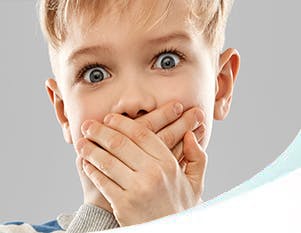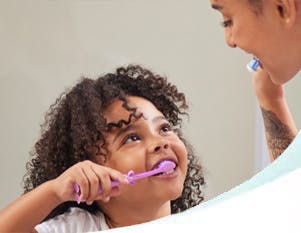HOW TO BRUSH YOUR TODDLER’S TEETH: DENTAL CARE FOR TODDLERS
Children are generally considered toddlers once they hit one year old; this stage continues until the child is around 3, or old enough for preschool.
Your toddler is learning how to navigate their world. They’re learning how to use their bodies and communicate with others and are constantly adjusting to new rules imposed on them by grownups. If you’re a parent or caregiver of a toddler, you know that they’re always on the go, but that instilling healthy habits is important. Learn how to brush your toddler’s teeth, what to do if they won’t participate and ways to avoid power struggles.
Key Takeaways
- Establishing Early Dental Habits Is Crucial. According to the ADA, most toddlers have all their baby teeth by age two, so it’s essential to start brushing with a smear of fluoride toothpaste twice a day using a soft-bristled toothbrush.1
- Preventive Dental Care Starts at Home and with Regular Checkups. Regular visits to the dentist and pediatrician support overall health.4 Habits like drinking water and discussing sealants with a dentist also support strong oral health.1
- Handling Power Struggles Requires Patience and Playfulness. Toddlers may resist brushing or healthy eating as a way to assert independence.5,6 Caregivers can reduce conflict by offering limited choices, modeling healthy behaviors.5,6
How to Brush Toddler Teeth
- Dental care for toddlers is just as important as it is for infants. By age two, your child should have a full set of primary teeth (baby teeth): ten on top and ten on the bottom.1 Parents and caregivers of toddlers can take note of these tips from the American Dental Association for brushing teeth:1,2,3Brush your toddler’s teeth thoroughly, using a smear of fluoride toothpaste no larger than a grain of rice.
- Use a soft-bristled toothbrush designed for children with a thick handle and small head.
- Brush twice a day as part of their routine: after breakfast and before bedtime.
- Move the toothbrush in gentle circles over all sides of the toddler’s teeth at a 45-degree angle for optimal cleaning results.
- Clean in between your child’s teeth with floss to clean out any food particles that have been left behind after eating.
Adults may need to facilitate brushing for small children to ensure that they’re brushing for long enough (the American Dental Association recommends two minutes) and that all the teeth are receiving attention.
Help keep your children’s teeth strong and healthy with Pronamel Kids toothpastes in Berry Twist and Bubble Twist. These fluoride toothpastes were designed by dentists and formulated for children. They’re gentle on little mouths and provide 24-hour cavity protection.^
Why Is Toddler Dental Care Important?
Dental caries, or cavities, are the most common chronic childhood disease, with 23% of US children aged 2-5 years old experiencing tooth decay that leads to cavities.4 This first set of teeth is necessary for chewing, speaking and smiling.2 They also create the necessary space for adult teeth to come in properly.2
How Can Adults Care for Toddler Teeth?
There are a few different ways that parents and caregivers can prioritize oral health for toddlers:
Regular Dental and Pediatric Visits
Caregivers should make the child’s first dental appointment within six months of the appearance of the first tooth.1 This visit is mostly for a dentist to check for growth and development, but is also an opportunity to:1
- Discuss teething, pacifier use or thumb sucking habits.
- Inspect for oral injuries.
- Let caregivers know if the child is at risk for developing tooth decay.
Establishing regular visits to the dentist is an important step for caregivers of toddlers. It’s also important for caregivers to continue with well child visits and checkups with their pediatrician.4 At a young age, toddlers are more likely to see a doctor than a dentist, so it’s important for a pediatrician to be versed in oral health topics.4 However, a doctor-however knowledgeable-is not the same as a child receiving professional dental care and cleanings. Some pediatric practices may even coordinate care with dental offices!4
Avoid Baby Bottle Tooth Decay
Infants and toddlers who are allowed to take a nap or go to bed with a bottle may experience decay known as baby bottle tooth decay. This is preventable by not allowing your child to take a bottle or sippy cup to bed or nap with them.1
Using a Fluoride Toothpaste
Fluoride is a naturally occurring mineral that is added to toothpastes and helps to repair weakened tooth enamel.1 Brushing with toothpaste that contains fluoride is an incredibly effective method of cavity prevention, but drinking plain water that contains this mineral can help too!2,3
Eating a Healthy Diet
Keep an eye on your toddler’s diet.2 The bacteria that lead to cavities and tooth decay feed on sugary foods and drinks, even ones that might seem healthy at first glance like, fruit.2 As toddlers become more independent and seek to have control over some aspects of their lives, dinnertime can often turn into a battlefield.5 It’s up to parents and caregivers to choose healthy foods.5
Dental Sealants
Your dentist may recommend sealants to cover the pits and grooves in your child’s molars.2 These are an effective way to maintain an effective chewing surface while preventing tooth decay!2 Talk to your toddler’s dental care team about their recommendations.
Toddler Power Struggles: Healthy Eating & Tooth Brushing
“How can I get my toddler to brush their teeth” and “how can I get my toddler to eat healthy food” are two common questions from caregivers and parents. Young children are frequently seeking control and independence.5 This may extend to what they do (or do not) want to eat or a power struggle about oral health.
To encourage healthy eating, caregivers can try these tips:5
- Serve appropriately sized portions. Too much food on a plate might feel overwhelming to a toddler.
- Don’t negotiate. Prepare a healthy meal and let the child decide what to eat. Encourage them to try everything but don’t fall into a back and forth about green beans.
- Eat together. Kids are more likely to eat a more nutritious diet if they regularly eat with family and everyone eats the same healthy food.
- Avoid junk food. You don’t have to say yes when a toddler asks for candy. Instead, caregivers can offer healthy snacks to toddlers.
When it comes to children who don’t want to brush their teeth, there are lots of ways to encourage them to brush, like singing a song or allowing them to choose their own special toothbrush.6
Learn more about caring for your child’s teeth with Pronamel Kids’ Oral Health Tips .
^Follow a healthy diet and brush twice daily. (Level of protection may decrease between brushings.)
Source Citations:
- Baby Teeth. MouthHealthy. https://www.mouthhealthy.org/all-topics-a-z/baby-teeth. Accessed 5/16/25.
- Healthy Habits. MouthHealthy. https://www.mouthhealthy.org/life-stages/babies-and-kids/healthy-habits-babies-and-kids. Accessed 5/16/25.
- Toothbrushing Tips for Young Children. Healthy Children. https://www.healthychildren.org/English/healthy-living/oral-health/Pages/Toothbrushing-Tips-for-Young-Children.aspx. Accessed 5/16/25.
- Maintaining and Improving the Oral Health of Young Children. American Academy of Pediatrics. https://publications.aap.org/pediatrics/article/151/1/e2022060417/190307/Maintaining-and-Improving-the-Oral-Health-of-Young?autologincheck=redirected. Accessed 5/16/25.
- Toddlers at the Table: Avoiding Power Struggles. KidsHealth. https://kidshealth.org/en/parents/toddler-meals.html. Accessed 5/16/25.
- Let the Brushing Games Begin. Healthy Children. https://www.healthychildren.org/English/healthy-living/oral-health/Pages/let-the-brushing-games-begin.aspx. Accessed 5/16/25.





